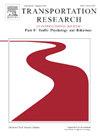The relationship between parental bicycle helmet use and that of their children
IF 3.5
2区 工程技术
Q1 PSYCHOLOGY, APPLIED
Transportation Research Part F-Traffic Psychology and Behaviour
Pub Date : 2025-05-03
DOI:10.1016/j.trf.2025.04.023
引用次数: 0
Abstract
Understanding the factors influencing children’s safety practices, such as helmet use, is essential for developing effective interventions. This study investigates the relationship between parental bicycle helmet use and their children, focusing on parental attitudes and behaviours. The study was conducted in Sør-Trøndelag, Norway, with 103 parent–child dyads (children aged 10–16) using convenience sampling and a cross-sectional survey. The primary aim was to assess whether parental attitudes or behaviours more strongly predict children’s helmet use and examine if child age and sex moderate these relationships. The survey evaluated cycling frequency, helmet use, perceived social norms and the costs and benefits of helmet use. Although nearly all children owned helmets, they wore them less frequently than their parents. A positive correlation was observed between parent and child helmet-wearing and cycling, indicating parental behaviour’s significant role in shaping children’s safety practices. An Actor-Partner Interdependence Model was used to understand the attitudes and behaviour of children in relation to helmet wearing, while accounting for the influence of the parent attitudes and behaviour. When this dyadic relationship was considered, the impact of parental attitudes on children’s helmet use was indirect, mediated through children’s own attitudes, and younger children mimicked parental behaviour more than older children. These findings highlight the importance of parental modelling in encouraging helmet use. Interventions should focus on enhancing parental engagement and addressing children’s perceived barriers. By elucidating the dynamics of parental influence, this research aids in developing effective safety campaigns to promote helmet use and cycling safety for young cyclists.
家长自行车头盔使用与子女自行车头盔使用的关系
了解影响儿童安全行为的因素,如头盔的使用,对于制定有效的干预措施至关重要。本研究以父母的态度和行为为重点,探讨父母使用自行车头盔与孩子的关系。该研究在挪威的Sør-Trøndelag进行,采用方便抽样和横断面调查的方式对103对父母-子女(10-16岁的儿童)进行调查。主要目的是评估父母的态度或行为是否能更有力地预测儿童头盔的使用,并检查儿童的年龄和性别是否能调节这些关系。该调查评估了骑车频率、头盔使用情况、感知到的社会规范以及使用头盔的成本和收益。虽然几乎所有的孩子都有头盔,但他们戴头盔的频率比他们的父母要低。父母和孩子戴头盔和骑自行车之间存在正相关关系,这表明父母的行为在塑造儿童安全实践中起着重要作用。行动者-伙伴相互依赖模型用于了解儿童对佩戴头盔的态度和行为,同时考虑到父母态度和行为的影响。当考虑到这种二元关系时,父母态度对儿童头盔使用的影响是间接的,通过儿童自己的态度来调节,年幼的儿童比年长的儿童更容易模仿父母的行为。这些发现强调了父母示范在鼓励使用头盔方面的重要性。干预措施应侧重于加强家长参与和解决儿童感知到的障碍。通过阐明父母影响的动态,本研究有助于制定有效的安全运动,以促进头盔的使用和青少年骑自行车的安全。
本文章由计算机程序翻译,如有差异,请以英文原文为准。
求助全文
约1分钟内获得全文
求助全文
来源期刊
CiteScore
7.60
自引率
14.60%
发文量
239
审稿时长
71 days
期刊介绍:
Transportation Research Part F: Traffic Psychology and Behaviour focuses on the behavioural and psychological aspects of traffic and transport. The aim of the journal is to enhance theory development, improve the quality of empirical studies and to stimulate the application of research findings in practice. TRF provides a focus and a means of communication for the considerable amount of research activities that are now being carried out in this field. The journal provides a forum for transportation researchers, psychologists, ergonomists, engineers and policy-makers with an interest in traffic and transport psychology.

 求助内容:
求助内容: 应助结果提醒方式:
应助结果提醒方式:


